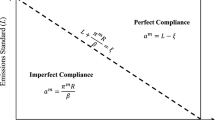Abstract
This paper constructs an optimal incentive tax/subsidy scheme in an oligopoly market with pollution, as a generalization of the Loeb-Magat scheme, which is nondiscriminatory and requires less information for implementation than the conventional ones. Some interesting properties of the scheme are discussed.
Similar content being viewed by others
References
Baron, D. P., and R. B. Myerson. 1982. “Regulating a Monopolist with Unknown Costs.”Econometrica 50: 911–930.
Cech, P-A. 1991. “Market Efficient Oligopoly Regulation: An Incentive Compatible Mechanism.” Working Paper, Northwestern University.
Dasgupta, P., P. Hammond, and E. Maskin. 1980. “On Imperfect Information and Optimal Pollution Control.”Review of Economic Studies 47: 857–860.
Dixit, A. 1986. “Comparative Statics for Oligopoly.”International Economic Review 27: 107–122.
Koenig, E. F. 1985. “Indirect Methods for Regulating Externalities Under Uncertainty.”Quarterly Journal of Economics 100: 479–493.
Laffont, J. J. 1977. “More on Prices vs. Quantities.”Review of Economic Studies 44: 177–182.
Laffont, J. J., and J. Tirole. 1986. “Using Cost Observation to Regulate Firms.”Journal of Political Economy 94: 614–641.
Loeb, M., and W. A. Magat. 1979. “A Decentralized Method for Utility Regulation.”Journal of Law and Economics 22: 399–404.
Meran, G., and U. Schwalbe. 1987. “Pollution control and collective Penal ties.”Journal of Institutional and Theoretical Economics 143: 616–629.
Riordan, M. H., and D. Sappington. 1987. “Awarding Monopoly Franchises.”American Economic Review 77: 375–387.
Sappington, D., and D. Sibley. 1988. “Regulating without Cost Information.”International Economic Review 29: 297–306.
Segerson, K. 1988. “Uncertainty and Incentives for Nonpoint Pollution Control.”Journal of Environmental Economics and Management 15: 87–98.
Shaffer, S. 1989. “A First-Best Regulatory Tax for Oligopoly.”Journal of Regulatory Economics 1: 373–389.
Shleifer, A. 1985. “A Theory of Yardstick Competition.”Rand Journal of Economics 16: 319–327.
Sibley, D. 1989. “Asymmetric Information, Incentives and Price-Cap Regulation.”Rand Journal of Economics 20: 392–404.
Spulber, D. F. 1988. “Optimal environmental Regulation under Asymmetric Information.”Journal of Public Economics 35: 163–181.
Weitzman, M. L. 1974. “Prices vs. Quantities.”Review of Economic Studies 41: 477–491.
Weitzman, M. L. 1978. “Optimal Rewards for Economic Regulation.”American Economic Review 68: 683–691.
Author information
Authors and Affiliations
Rights and permissions
About this article
Cite this article
Kim, JC., Chang, KB. An optimal tax/subsidy for output and pollution control under asymmetric information in oligopoly markets. J Regul Econ 5, 183–197 (1993). https://doi.org/10.1007/BF01065365
Issue Date:
DOI: https://doi.org/10.1007/BF01065365



